Seeds & Fertilizer
Whether you garden big or small, cottage-style or formal, these popular flower types will fit your landscape.
Tulips are one of the first flowers to bloom in spring, and come in a rainbow of color options.
The rosy, purple-colored blooms of anemones make a soft statement.
When it comes to gardening, not all soil is created equal. You might have lived up until now unaware of what topsoil is and the benefits it has for our garden as a natural fertilizer, but it’s not a one-size-fits-all approach to filling pots or flower beds.
Topsoil might be good for some elements of your modern garden, but there are some instances where it can actually cause more harm than good, and it’s important to give our garden a little extra care to ensure it is getting all the essential nutrients it needs to stay healthy.
Tony O’Neill, ‘it’s where you’ll find the highest concentration of organic matter and microorganisms.’
However this nutrient-dense substance is not automatically there, and actually takes a considerable amount of time to form. ‘On average, it takes about 500 years for nature to create just 1 inch of topsoil,’ explains Brock Ingham, editor of Bigger Garden. ‘This slow formation process involves the gradual decomposition of organic matter, weathering of rocks, and the activity of various organisms.’
This much-desired resource is also scarce for another reason. It is being rapidly depleted due to our modern-day gardening and farming techniques. ‘Deforestation, intensive agriculture, and improper land management practices can accelerate topsoil erosion and depletion, which can have detrimental effects on ecosystems and food production,’ says Brock. As a result of this depletion farmers have become reliant on chemical fertilizers to do the job top soil once did and achieve good growing results. Brock urges us to appreciate the importance of topsoil and look to rebuild it, saying: ‘It’s as important as ever to rebuild this “black gold” as much as we can for future generations for years to come.’
Why is it good for your garden?
The benefits of topsoil are many, so get a notebook and pen, you are going to want to remember this. Overall it helps to improve the key elements of plant health but it does this in a multitude of different ways, as out experts explain. ‘Topsoil is often used to provide a fertile and supportive environment for their initial growth,’ says Brock. ‘It helps establish a healthy root system and aids in nutrient uptake. But it can also be used in the case of established plants, for replenishing nutrients, improving soil quality, or filling in gaps where soil may have eroded or been removed.’
Topsoil is packed full of essential nutrients necessary for growing healthy plants, such as nitrogen, phosphorus, potassium, and micronutrients. Unlike your average fertilizer these are all naturally occurring. ‘Topsoil contains a significant amount of organic matter, including decomposed plant and animal residues. This organic matter improves soil structure, enhances moisture retention capacity, and promotes beneficial microbial activity,’ he explains.
Not only does it aid young plants in their initial growth, it also improves soil structure and water retention and drainage. Further helping to establish strong plants. ‘Knowing when to use topsoil is crucial,’ says Tony, ‘adding topsoil can be an excellent solution if your soil is poor in quality, lacks organic matter, or is heavily compacted. Similarly, if you’re starting a new garden or restoring a worn-out lawn, topsoil will give your plants the nutrient-rich environment they need to thrive.’
When should I use topsoil?
Topsoil’s benefits are plentiful, and as a result so are its uses. It can help with a wide range of things from average gardening to full blown landscaping. It can be difficult to know where to begin with so much choice. Take a look over these suggestions from the experts and discover the benefits topsoil could bring to your space.
‘Topsoil is rich in nutrients, making it the most fertile type of soil. It is generally used when establishing new gardens, lawns, or landscapes,’ says Stephen Sullivan editor at the Plant Native. ‘It is particularly beneficial in areas with poor soil quality,’ he says. Tony from simplifying gardening echoes this, ‘it’s a primary component when creating new flower beds, filling in holes, or levelling your lawn. You can also use it to improve the nutrient content in areas where you plan to grow demanding crops.’
Another use for topsoil in when you need to improve drainage. As previously mentioned due to the improved soil structure and water retention topsoil drains effectively whilst facilitating nutrient uptake and supporting various physiological processes. ‘Because topsoil drains so efficiently, the more you add, the better your grass or plant bed drainage will be,’ advises Izzy Goldberg, a Landscaper at White Maple Landscaping.
‘Mix topsoil into the area where you intend to plant for the optimum drainage, then add another layer of topsoil on top.’ Your dehydrated plants will thank you for this one.
When shouldn’t I use topsoil?
Despite all its benefits, there are a few situations in which topsoil is not the appropriate choice and may do more harm than good. ‘One time you shouldn’t use topsoil is when you’re creating a specialized planting environment that requires specific soil compositions or conditions,’ says Dan Bailey, president of WikiLawn. ‘Certain plants have unique soil requirements, such as acidic soil for blueberry bushes or well-drained sandy soil for succulents. In such cases, using topsoil may not be suitable because it might not provide the optimal conditions or nutrients needed for the specific plant,’ he says.
Other plants that are hindered by topsoil include epiphytic and aquatic plants. ‘Epiphytic plants, such as certain orchids, naturally obtain nutrients from the air, rain, or debris that accumulates around them. These plants typically do not require traditional topsoil for growth and can be harmed by the added moisture and water retention that topsoil provides,’ says Brock Igham from the bigger garden. ‘Plants that grow primarily in water, such as water lilies or water hyacinths, have adapted to aquatic environments and do not require topsoil for their growth. Instead, skip the topsoil and focus more on your water PH.’
Topsoil is not always appropriate or necessary. You might want to reconsider using it where you already have adequate soil quality or in areas prone to waterlogging as this could worsen the issue. Similarly, you should consider using the best potting mix for containers when dealing with potted plants.
‘One situation where the use of topsoil may not be appropriate is in areas where native plants thrive,’ says Stephan, ‘introducing topsoil may disrupt the natural ecosystem.’ Topsoil is often sourced from multiple locations, meaning it can contain invasive species that could contaminate your garden. Keep this in mind when introducing topsoil to areas of your garden with particularly sensitive native plants live.
Where to buy
Scott’s Premium Topsoil
Controlling insects in the vegetable garden

Whether it’s tomatoes off the vine or leafy greens, you can enjoy your own vegetables from your garden. Find out what varities grow best in your zone and plant seeds according to their instructions.
A sunny spot is essential; some veggies require full sun while others thrive in shade. Space plants appropriately to prevent overcrowding.
Do you know why the vegetable band sounded a little off at the concert the other night? They were missing a beet.
On any given summer evening, you can usually find me in one of two places. I’m either in the front yard, working in the flowerbeds, or in the backyard, weeding the vegetable garden.
I don’t remember a time I wasn’t in the vegetable garden. I grew up gardening with my mom, and my wife, Mary, and I have gardened our 39 married years.
During these years of gardening, there have been two constants: weeds and insects. There’s never been a year we didn’t hoe weeds, and there’s never been a year insects haven’t attacked.
Luckily for gardeners, there are effective, safe remedies to save our vegetables from being decimated by insects. And crops can be decimated. Take potatoes, for example. The Colorado potato beetle can ruin plants in a matter of days if unchecked.
ADVERTISEMENT
Let’s discuss the most commonly encountered vegetable insects, and then examine the insecticides that are handy to keep on the garden shelf.
Flea beetles. They often go unseen because they’re so small, and it’s usually their damage that reveals their presence. These small, black, pinhead-size beetles cause small shot-hole damage to the leaves of radish, kohlrabi, cabbage, cauliflower and broccoli. Because their activity begins early in the season when plants are young, flea beetles can cause significant damage.
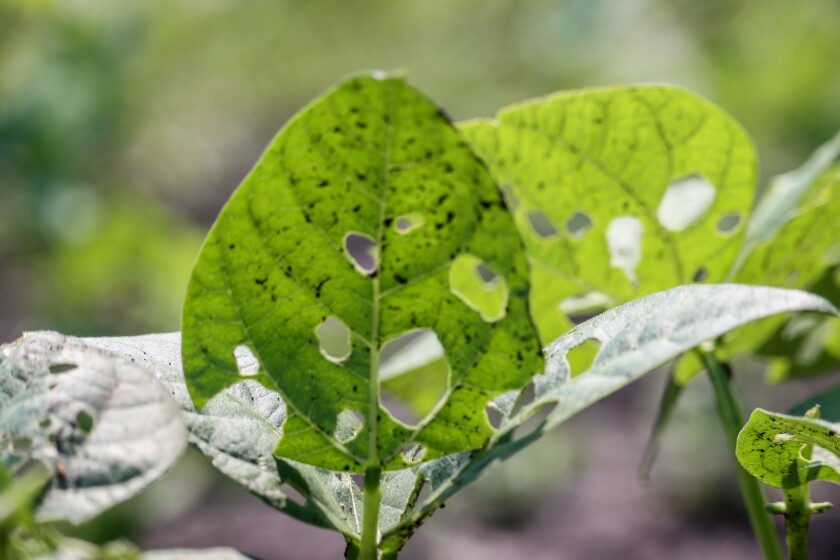
Michael Vosburg/The Forum
Bean leaf beetles. Although they’re larger than flea beetles, it’s usually their extreme feeding we first see. The quarter-inch tan beetles with black spots feed on the undersides of string bean plants, causing large holes, and plants can be quickly skeletonized and ruined.
Colorado potato beetle. These fat, round, half-inch beetles are easily spotted on potato plants, with their yellow bodies and black stripes. Newly hatched larvae are brick red with black heads. Adult beetles and larvae can quickly turn potato plants to skeletons. My Dad talked of walking their potato patch and handpicking beetles and dropping them in a can of kerosene, which is still a control option.
Cabbage worm. Also called cabbage loopers, these green larvae hatch from eggs deposited by white or yellow cabbage butterflies that flitter through the garden. The hungry, green worms create holes in cabbage and its close relatives, cauliflower and broccoli.

Michael Vosburg/The Forum
Striped Cucumber beetle. As the name describes, these yellow-bodied beetles have black stripes, are about one-fifth inch long and are longer than wide. They attack cucumbers and their close relatives squash, pumpkins, watermelon and muskmelon. Besides feeding on the leaves, they can carry bacteria that cause a wilting disease.
Squash vine borer. Extremely prevalent, these insects quickly ruin a crop of squash and sometimes melons, pumpkins and cucumbers. The adult moth begins laying eggs on the basal stems of squash plants in late June or early July. The eggs hatch into larvae that tunnel into the squash stem, causing vines to quickly wilt as though they’re dry. They might recover at night, but vines soon collapse and won’t recover. Preventative insecticides are applied to the lower 12 to 24 inches of squash stem from soil level upward. Butternut varieties carry some resistance.
Luckily we don’t need separate insecticides for each of these common pests. The following products are handy to keep on the garden shelf, since they’ll safeguard vegetables from a number of the pests listed. Always read and follow the label instructions.
ADVERTISEMENT
Sevin and Eight. I’ve found them to be somewhat interchangeable in managing many of the insects described, so I keep one or the other on hand. Insects controlled are listed on the labels.
Spinosad. This will be listed on the label as the active ingredient, and there are several brand names. Besides controlling many other insects, it’s currently the most effective control for Colorado potato beetle, which has become resistant to many other insecticides. Spinosad is an organic compound.
Malathion. Although it’s been around a long time, it remains an effective product.
Bacillus thuringiensis. Abbreviated BT, this organic material is effective against cabbage worms and other larvae, if applied when larvae are young.
Other organic insecticides. Neem oil and insecticidal soap can control many insects, but they must contact and coat the insect’s bodies. They generally don’t have the residual of other insecticides that remain effective as insects eat leaves.
A note about dusts versus sprays: Both can be effective, but sprays can provide better plant coverage. Liquid concentrates are easily mixed and applied with small pump-type sprayers.
Source: inforum.com
Colorado gardening: What is bolting, why it happens, and what to do

Flowers make great gifts and offer a variety of symbolism. They also look great in a flower garden or container.
From beginner plants to varieties for the pros, here are some of the most popular flower types. These plants are easy to grow from seeds in a Zone 3 or similar climate and come back year after year.
As July begins, the cool and wet start of the growing season with moments of warm weather affected vegetables in a variety of ways. For some annuals, this means they have bolted. (Insert a screaming face on every gardener.)
OK, so bolting is not a problem in and of itself. It is the plant doing what it needs for survival. Bolting means a plant has gone to seed, shifting its energy away from growing roots and the edible parts we like. Instead, it starts planning for its future: seeds. Technically, bolting refers to a premature flowering, often before you have fully (or at all) harvested. All annuals will flower at some point. Ideally, not until they have had a full cycle and harvest.
Bolting happens when plants are stressed. One of the main stressors for cool-weather crops is when the temperature changes to hot. Here on the Front Range this season, we have had a wide range of temperatures, which creates stress. The longer, cooler, rainy start should have meant the cool-weather vegetables had a longer growing time. However, in my garden the spinach and arugula both bolted weeks ago.
Other stressors are water stress and pests. Some gardens may be experiencing more of these this year due to overwatering from constant rains or poor drainage. Too much water can cause root rot which makes plants weaker. This then invites pests. It’s a vicious cycle that requires monitoring.
What to do?
It is common that cool weather crops have a shorter season here in Colorado, where we are in Zone 5 along much of the Front Range. We even have warm microclimates of Zone 6. These warmer climates make these vegetables regular bolters: spinach, lettuce, cilantro, broccoli, cauliflower, and onions.
Spinach

Spinach is a cool-weather crop and is hot-temperature sensitive. You can tell when spinach starts to bolt when its leaf shape changes from rounded to arrowhead. As spinach will not continue to produce enjoyable leaves once it has started bolting, you can harvest and eat what is there. If you find the leaves bitter, cooking them will reduce that a bit.
Some varieties state they are “slow bolt” or heat tolerant, which may extend your spinach season. You could plant them under a shade cloth and harvest baby spinach before it has a chance to bolt. Although spinach seeds will not germinate in soils above 85 degrees. Spinach-like options to try in the heat of summer instead are New Zealand and Malabar spinach. Save the true spinach varieties for fall planting.
Kale is a biennial, meaning it will not bolt until the second year or after a winter. This makes kale varieties great alternatives to spinach here, with our summer heat.
Lettuce
Know that lettuce is definitely cool weather and when the heat turns up it often gets bitter. The best tip is to try and outsmart lettuce bolting by selection and interval planting. Plant leafy lettuces over head lettuces. Leafy lettuces allow for faster harvesting times because you are not waiting on the whole head to mature.
Look for “cut-and-come-again” varieties that are also heat tolerant, like Black Seeded Simpson, Red Sails or Oak Leaf. You can cut them about an inch from the base and they will grow new leaves. Another way to slow bolting on these is to harvest the larger outside leaves regularly and first. Leaving on large outside leaves may send the plant a message to flower.
The second tip for lettuce is to plant rows of lettuce seeds in succession, meaning stagger your rows. Plant baby leaf lettuce at intervals of every seven days and full-size lettuce every 10 days. This allows you to lengthen a harvest. Just as one row starts bolting, the next is ready to eat.
Other leafy vegetables that are known bolters and become bitter are arugula, watercress, and sorrel.
Onions

Like kale, onions are biennials, meaning they grow bulbs in the first year and flower in the second. If your onions are flowering and you planted them this year, then they are bolting. Our big swings in temperature are a huge stressor for onions. Cold weather after warm weather tells them to go dormant. Then it warms up, so they think it is their second season.
If you have bulbs of any size, harvest the onions right away and eat or preserve. They will not keep long. Unfortunately, cutting off the flower stalk will not restart bulb growth. You can leave the onion flower to harvest seeds later. Also, onion flowers are a favorite of bee pollinators for their nectar and pollen.
Garlic
Here is when bolting is good news for your taste buds. When hard-neck garlic sends up a stalk from the center of the plant, you can cut that off and voilà, you have garlic scapes. Yum. You can sauté them or make them into pesto. And unlike the onions, cutting off the flower will send the plant back into bulb growing. However, only cut off the stalk after it has curled up. If you planted soft-neck garlic, they do not send up a hard stalk and rarely bolt. If they do, you still can harvest bulbs (they just grow fewer of them).
Herbs
Many common herbs remain edible after flowering. Parsley bolts but stays edible, even the flower. You can employ a similar technique to the cut-and-come-back method to get multiple harvests out of your parsley. Similarly, mint flowers nicely and the plant continues growing but as it is a fast spreader you may want to remove the flowers before they seed. When basil flowers, cut off the flowers and the plant will grow bushier. Chives flower beautifully; pollinators and people alike enjoy their flavor.
Cilantro is the one herb that is different than these others. It does not like hot weather and once it flowers it gets lanky and bitter. This herb is a great one to plant in intervals and in shadier areas. Cilantro in our climate will not reseed itself because the seeds will not survive our winters. If you do allow cilantro to seed, save them and plant next season.
Brassicas
The members of the cabbage family that are known bolters are bok choi, broccoli and cauliflower. Head cabbage are biennials and will bolt with extreme variations in temperature that have convinced them they are in their second season. Caterpillars are also known stressors for this category of vegetable.
Know that broccoli bolting is very common. This is visible when the head starts to become looser because it is getting ready to flower. If you notice this, cut and eat right away. That plant has completed its cycle. While labels on broccoli may say they need full sun, that does not necessarily mean full Colorado sun. As for many of the annuals discussed, a sun shade will help reduce the speed of bolting.
Subscribe to our weekly newsletter, In The Know, to get entertainment news sent straight to your inbox.
Source: denverpost.com
Planting new life: Dallas vegetable garden gives hope to trafficking victims
About Starting A Vegetable Garden
Grow your tried-and-true favorites or try something new. Consult your growing zone chart to see which vegetables will thrive in your climate.
Plant seeds in the right soil type and location to ensure a bountiful harvest. Sprinkle a balanced organic fertilizer on the ground before or after planting.
Any gardener knows that a successful garden requires patience, commitment and tender, delicate care. Some Dallas residents are learning when they do just that, they can reap a whole lot more than what they’ve sowed.
A new garden in the Wilson Historic District gives survivors of trafficking and exploitation the chance to not only plant peppers, purple peas and zucchinis, but new lives of their own
“For some of these ladies, this is the first job they’ve ever had,” said Kim High, the garden’s farm director. “Putting your hands in that dirt, it’s just absolutely therapeutic. It’s just like something touches you or something.”
The Meadows Foundation, New Friends New Life and Bonton Farms broke ground on a new 1-acre project labeled the Liberty Street Garden. The garden, funded through a Meadows Foundation grant, will give survivors of trafficking and exploitation a shot at a steady hourly job that provides organic fruits, vegetables and herbs to farmers markets and local restaurants in Dallas.
The garden will provide six members of the New Friends New Life women’s program with a part-time gardening position. The women will work alongside High, a celebrated gardener in her own right, to grow fresh produce, and earn $10 an hour. The apprenticeships are slated to last about 6 to 9 months, with room for promotion.
“Working at Liberty Street Garden allows (a survivor) to build her skills while earning an income in a space where she knows that she is accepted, valued and capable,” said Bianca Davis, the CEO of New Friends New Life. “And how serendipitous that this garden exists on a street named Liberty. You can’t make that up.”
The Meadows Foundation, a wide-ranging charity focused on improving life in Texas, helped create the project with New Friends New Life, a charity that helps to empower trafficked and sexually exploited teen girls, women and their children. Together, with the help of the South Dallas-based nonprofit Bonton Farms, the garden will help give the women “a tangible opportunity to soar above the limits of their past and achieve their dreams,” Davis said.
Gay Donnell Williams, City Council member from District 13 and vice chair of the Domestic Violence and Human Trafficking Advisory Council, said New Friends New Life has played a vital role in supporting survivors of trafficking and prostitution in the Dallas area for decades.
“People being able to work out here and just going through the cathartic exercise of tending to life, I think it’s going to be a big thing for them,” she said. “This is so critical, helping these folks be compensated, be in a role that is understanding of the trauma they’ve lived through, and it can help them reach that next step on a path to stability.”
Ollie, an apprentice at the Liberty Street Garden who asked to only be identified by first name, said she used to garden as a child with her grandmother, and working the garden brings back those special memories.
“It’s a joy doing the garden with these ladies, working with the people I’m around,” she said. “Everybody is getting along, no one is arguing, there’s a peace of mind.”
Source: dallasnews.com
New Zealand falls out of love with sheep farming as lucrative pine forests spread
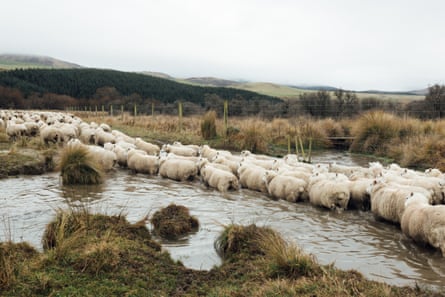
Growing crops and raising animals to produce meat, milk, wool or other raw materials is considered farming. Like any other business, farmers must research the market to find their buyer. One way to do this is through Community Supported Agriculture.
Across one of the ridgelines of High Peak station, a line of sheep is on the move: gradual at first, and then in a heaving rush, an avalanche of dirty white wool heading into the valley. They flow around Hamish Guild like an eddy.
He looks across the valley, to where a slope of grassland splits in half, a velvety black expanse of pine forest sweeping over the hill.
“We’ve made a decision as a family, we’ll hold on as long as we can,” says Guild, a second-generation sheep farmer whose family has occupied this land outside Christchurch since the 1970s.
“Ultimately, if we’re an oasis in a sea of forestry, that probably gives us a distinctive, compelling selling point,” he says, and laughs. “We might become a museum: this is how we used to farm in New Zealand in the 2020s.”
These sweeping high country sheep stations, thatched by golden tussock, are at the centre of New Zealand’s international image. For almost a century, lamb, mutton and wool were New Zealand’s largest source of agricultural and national revenue, and at its 1980s peak, the ratio of sheep to humans was more than 20 to one.
Now, sheep country is in sharp decline. Across the country, farm after farm is transitioning to lucrative pine forestry, fuelled by demand for carbon credits. Under New Zealand’s emissions trading scheme, landowners can earn credits – which can be traded or sold – for activities that absorb carbon dioxide. Farmland sold for forestry conversion can now fetch prices several times higher than its previous value as agricultural land. Over tens of thousands of hectares, wire fences are being ripped out and the paddocks studded with dark bushels of pine seedlings. New Zealand’s total flock number has fallen from more than 70 million in the 1980s to just 26 million today. This year, the ratio of sheep to people slipped below 5:1 for the first time since records began.
At the same time the international wool price has plummeted, reaching the point where the cost of shearing a sheep is more than the price of its fleece. Farmers are also facing far more scrutiny over their environmental practices. But a key driver over the last decade has been the rise of forestry, which offers a way to cash out for farmers under increasing economic and political pressure.
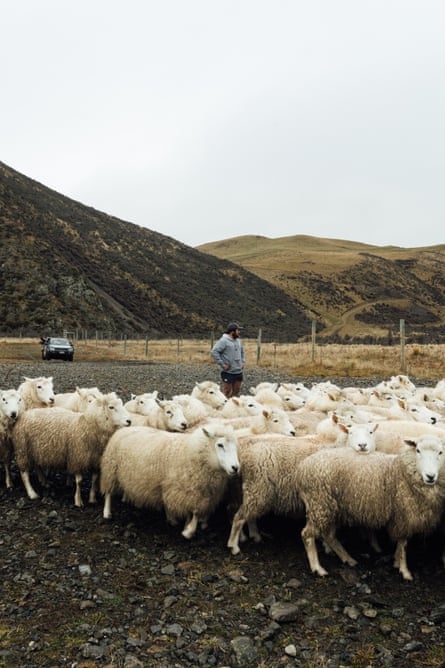
For New Zealand’s government, forestry is a central building block of its path to emissions reduction, and agricultural emissions are its most difficult obstacle. Nearly half of New Zealand’s greenhouse gas emissions come from agriculture – mostly methane from gassy livestock. Currently, tree-planting is at the centre of its roadmap to net zero. Discussing proposed changes to the emissions trading scheme, Associate Prof David Evison from the New Zealand School of Forestry at the University of Canterbury, said that using current technologies, the country will not get to net zero by 2050 “without a significant tree planting programme”. He estimates New Zealand could need another 1.7m hectares of new forest to meet its 2050 net zero emissions target.
But that strategy is also coming under increasing scrutiny. In April, the climate commission sounded alarm about New Zealand’s overreliance on forestry, arguing that achieving a net reduction in emissions primarily through planting trees would be impossible to sustain in the long term. After cyclone Gabrielle, the damage caused by forestry debris created a huge public backlash. In June, the government announced it would be reconsidering the role of pine forest in the emissions trading scheme.
Seeing farms around his region converting into pine plantations, “there’s conflicting emotions,” says William Morrison, a sixth-generation sheep farmer from Rangitikei, in central North island. “I always loved going out on the farm, and I guess with our family being on the land for so long, there’s just a pride and passion for farming.”
For many farmers, pine represents a potential economic boon, but it comes with a huge social and cultural loss, dissolving rural communities.
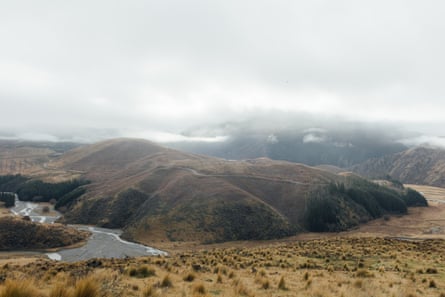
After an initial flurry of employment during planting, carbon forests require very little in the way of ongoing staffing. Without farming families to sustain them, rural schools, villages and businesses can empty out. The losses can have a domino effect, Guild says. The services that sustain small towns start to shut down and as farmers become increasingly isolated, surrounded by forest, they too start to consider leaving.
Research commissioned by industry body Beef and Lamb in 2022 found that 175,000 hectares of sheep and beef farms had been sold with the intent to convert into forestry since 2017, and the rate was increasing sharply: In 2021 more than 52,000 hectares was bought by forestry interests, compared to just 7,000 hectares in 2017. Forty per cent of that land was being bought up by overseas investors, looking to add carbon forests to their portfolios.
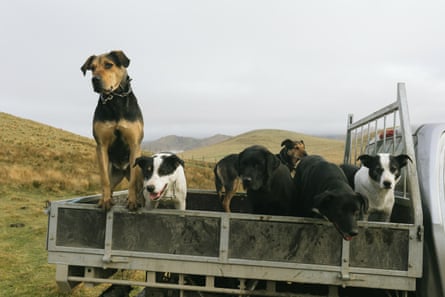
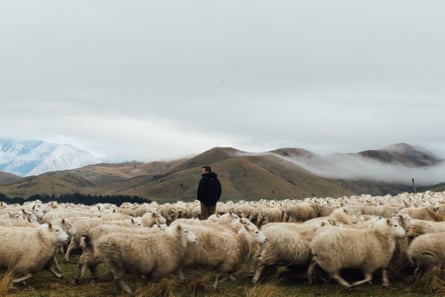
For environmentalists, the benefits of carbon-absorbing forests are tempered by concerns about expanding monocultures of radiata pine: an introduced, fast-growing species that can wreak havoc on native ecosystems, and cause catastrophic downstream effects when harvested. As the country wrestles with how to reconcile its climate obligations and farming economy, pine forestry sits at the thorny centre of the challenge.
“Pine trees – they are an important part of our economy, they are an important part of our response to climate change,” says Erica van Reenen, who is married to Morrison and runs an environmental consultancy. But the aftermath of forestry clearing can also have devastating environmental effects. Once land has been planted with pine, it’s very difficult to change it back. “It looks like the ground has been carved up. There’s piles of debris, bare soil everywhere – which when you are someone that knows the importance of topsoil, it’s very difficult to see.” For some farmers watching the landscape transform, there’s “a hatred of pine”, van Reenen says.
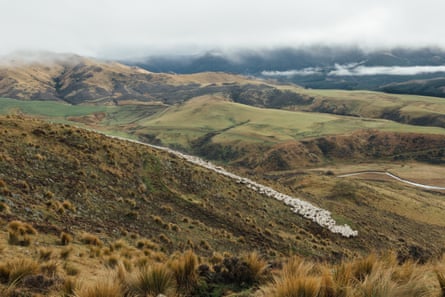
At High Peak station, clusters of sheep curl in a slow-moving whirlpool. Low-lying mist covers half of the station, gradually lifting as the morning warms. It rolls back over the expanse of pasture, tussock and bracken, stretching toward the ski slopes of Mount Hutt.
“If we were to look at it purely economically, we’d probably be best to put it all into trees,” Guild says. “The impact of that on the local community will be catastrophic … If we didn’t have those farms employing young families, that would disappear. And I guess that’s the heart of the community.
“It doesn’t mean blindly keep doing what we’re doing. But we will resist the forestry thing.”
Source: theguardian.com
Ten vegetables to sow now to reap the rewards in autumn and winter
:quality(70)/cloudfront-eu-central-1.images.arcpublishing.com/irishtimes/CZDMKF6UZMBRPPKAK36YXXUN7M.jpg?w=1200&resize=1200,0&ssl=1)
Starting A Vegetable Garden
There are so many exciting vegetables to choose from, but perusing seed catalogs and websites can be overwhelming for a new vegetable gardener. Start small and expand as your experience grows.
Know your USDA zones (based on average frost dates) and consult seed packets for planting information. Plan on a location that gets full sun, as most vegetables require it.
It seems strange, I know, to talk of growing winter crops for the polytunnel or glasshouse, smack-bang in the middle of a very sultry Irish summer. But the simple truth is that the secret to making the best, and most productive use, of these valuable covered growing spaces throughout the year has always been to plan and propagate very far ahead.
Sow seed throughout July and August, for example, while temperatures, light and growth levels are still high, and you’ll have plenty of baby vegetable transplants to grow under cover throughout the cool months of autumn, winter and early spring. In this way you can guarantee a steady supply of fresh, nutritious, home-grown produce long after the rest of the garden goes into hibernation.
Many kinds of leafy vegetables and herbs do brilliantly when grown this way and treated as cut-and-come-again crops, producing plenty of tender, juicy, flavoursome leaves over a long period of time. Examples include hardy winter varieties of lettuce, spinach, kale, chard, American landcress, lamb’s lettuce (also known as corn salad), chicory, rocket, winter purslane (also known as claytonia), texsel greens, oriental mustards, mibuna, mizuna, tatsoi, pak choi, choy sum, komatsuna, coriander, dill, sorrel, chervil and parsley.
July to early August is also an excellent time to sow seed of Florence fennel, beetroot, baby turnips, dwarf French beans, radish, kohl rabi, salad onions, sprouting broccoli and spring cabbage for growing under cover in the same way throughout the autumn, winter and early spring months of next year.
With covered growing space at such a premium during these busy growing months and temperatures at their hottest, these crops are generally best sown in the evening into pots, trays or modules and then placed on a garden table outdoors to protect them from slug and snail attack. Make sure to choose a warm, sheltered spot outdoors that’s bright but not in direct sun, and far away from any rank or weedy overgrowth. This is especially important when it comes to heat-sensitive species such as lettuce and spinach, which will germinate poorly or be inclined to bolt if seed is sown in the very high temperatures typically found inside polytunnels in high summer.
Klassmann’s peat-free organic seed compost stands head and shoulders above any other brand that I’ve used in terms of its overall quality and fine particle size
For reliable results, it’s also vital to use fresh, quality seed sourced from a reputable supplier. Most good garden centres still carry a decent selection at this time of year but you’ll find the widest choice online from great Irish suppliers such as mrmiddleton.com; seedaholic.ie; greenvegetableseeds.com; quickcrop.ie; giy.ie; theorganiccentre.ie and from the organic seed producer brownenvelopeseed.ie.
A good-quality seed compost is another must and makes a vast difference to germination rates as well as to the health and vigour of the resulting seedlings. Although it’s pricier and inexplicably difficult to find in most Irish garden centres, Klassmann’s peat-free organic seed compost stands head and shoulders above any other brand that I’ve used in terms of its overall quality and fine particle size (see quickcrop.ie and fruithillfarm.com).
Whichever brand you use, always make sure to dampen the compost before sowing, and to sow lightly and to the correct depth, gently pressing the seeds down on to the compost to ensure they make good contact with it. Really small seeds are generally best surface-sown or almost surface-sown, using the lightest layer of compost of vermiculite to cover them. To help to keep the upper layer of compost damp and friable (both are essential for good germination), I also always like to work some fine vermiculite into the top 5cm layer before sowing.
Whichever kind of tray, pot or container you plump for, just make sure to give it a quick wash before use in order to minimise the risk of disease
Bear in mind that root vegetables such as beetroot, turnips, radish, and bulbous species such as Florence fennel and kohl rabi typically dislike root disturbance, even as tiny, newborn seedlings. So to give these a really good start, I like to sow the seed singly into deep root trainers (available from mrmiddleton.com; quickctrop.ie; or nursery trays (available from fruithillfarm.com), which gives their root systems plenty of space. To further encourage good germination rates, I then cover these with a sheet of clear glass until I spot the first signs of baby seedlings pushing their way through the surface of the compost.
In comparison, leafy species of vegetables are typically more shallow-rooting and much more forgiving of root disturbance. For these, I typically sow the fresh seed into two-litre pots of damp seed compost, then cover them with an upturned clear freezer bag secured with an elastic band to lock in moisture and humidity until germination occurs. Once they’ve produced their first set of true leaves (leaves typical of the mature plants), they can then be pricked out into modular trays and grown on to a decent transplant size while I’m waiting for permanent growing space to be freed up in the tunnel.
Again, whichever kind of tray, pot or container you plump for, just make sure to give it a quick wash before use in order to minimise the risk of disease. For the same reason, do your best to practise crop rotation at planting time.
Last but not least, bear in mind that staggering sowings by succession-sowing small batches of seed at fortnightly intervals through July-August is a very useful way of further spreading out the harvesting period and avoiding gluts.
Ten vegetables to sow seed of this month for growing in the autumn-winter polytunnel
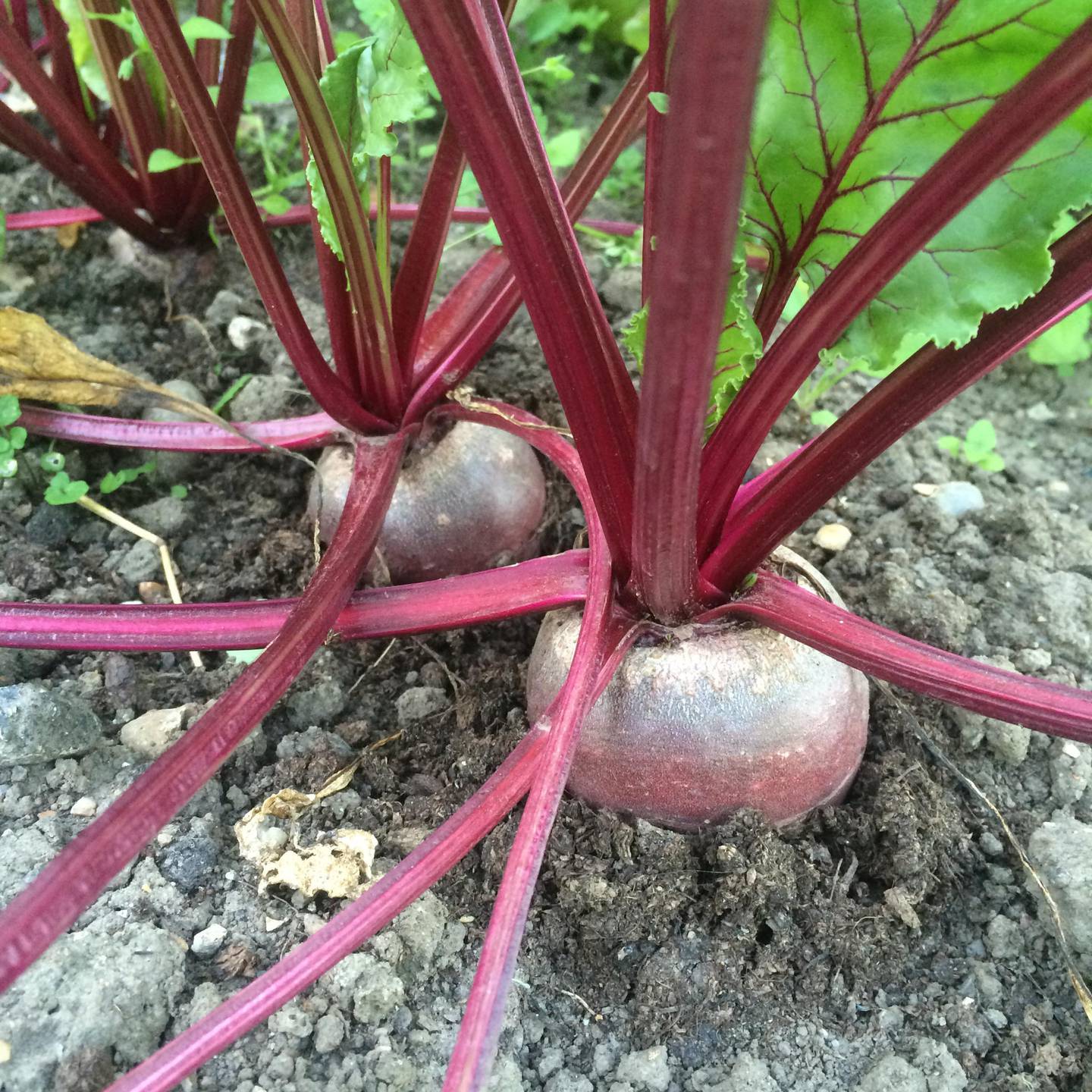
Turnip ‘Milan Purple Top’ and Turnip ‘Tokyo Cross’
Both have edible leaves and are tastiest when harvested for use as baby turnips.
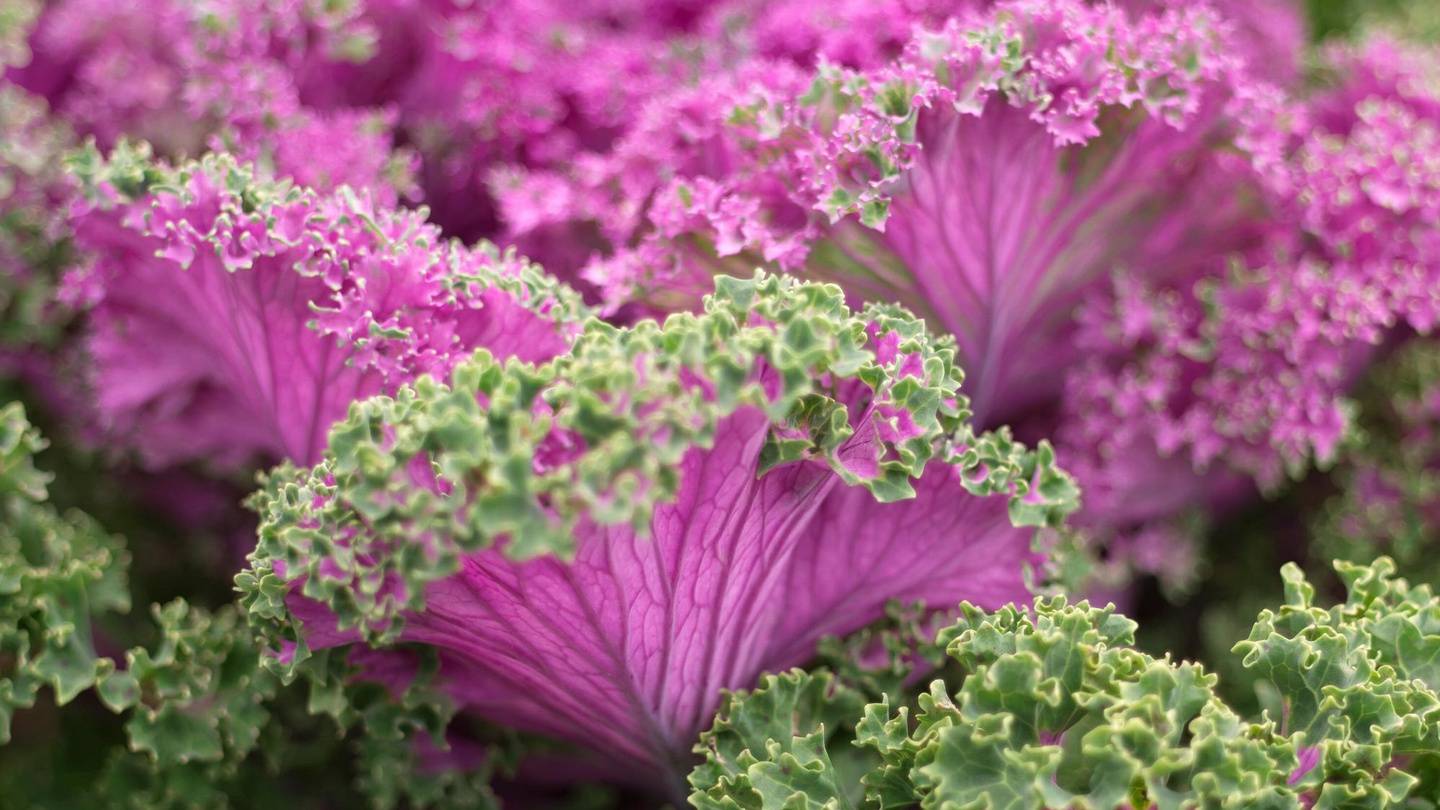
Kale ‘Ragged Jack’
A lovely, leafy member of the cabbage family grown for its very pretty, nutritious pink-and-green baby leaves, which can be eaten in a salad or stir-fry.
Swiss Chard ‘Bright Lights’
A great alternative to spinach, this leafy, nutritious. versatile colourful vegetable is a stalwart of the winter polytunnel.
Beetroot ‘Boltardy’ or ‘Boro’
Two ultra-reliable bolt-resistant varieties suitable for cropping in late winter-spring from a July sowing.

French beans
Sow asap and look for the dwarf variety known as ‘Faraday’ for a late autumn crop.
Radish ‘Red Meat’
Also sometimes sold as ‘Watermelon’, this variety produces large, round, scarlet-fleshed radishes that are delicious eaten raw, pickled, fermented or used in a winter salad or stir-fry.
Kohl rabi ‘Azur Star’or ‘Kolibri’
Two pretty, flavoursome, purple-skinned varieties of this bulbous member of the brassica family. Both bulb and leaves are edible and can be used raw or cooked.
Florence fennel ‘Rondo’
An excellent, high yielding bolt-resistant variety of this heat-loving versatile vegetable.
Lettuce: ‘All the Year Round’
A classic butterhead variety with crisp flavoursome leaves.
Mixed oriental salad leaves
Widely available as a mix of varieties including mibuna, mizuna, mustard, pak choi, komatsuma, and Chinese cabbage, this is a great cut-and-come-again crop for polytunnel growing
This week in the garden
Wisteria should be pruned for the second time this year (this fast-growing ornamental climbing plant should also be pruned every January-February), both to keep it floriferous and to prevent it from outgrowing its allotted space. To do this, use a sharp, clean secateurs to cut the new, slim, whippy growth back to five-six leaves, or typically 15cm/6 inches. If the main stems of the plant have reached as far as you want them to grow, nip out their growing tips also.
Summer containers can start to look a little tired at this time of year unless regularly maintained. To help keep them looking their best, deadhead the plants thoroughly, nip off any dead or damaged foliage, remove and replace any dead plants, and start giving them a generous liquid feed every fortnight.
Dates for your diary
Saturday, July 1st & Sunday, July 2nd (11am-5pm): Galway Castle Garden Festival, Claregalway Castle, Co Galway, with a range of talks by guest speaker, plant sales by many of the country’s leading nurseries, exhibitions of botanical art, music, craft and entertainment, admission €10 (children free). galwaygardenfestival.com
Sunday, July 9th (10am-5pm): Fruitlawn Garden, Abbeyleix, Co Laois, the annual Open Day of plantsman and designer Arthur Shackleton’s garden and artist Carol Booth’s studio, with rare plants and artwork for sale. arthurshackleton.com, carolbooth.ie
Source: irishtimes.com





:quality(70)/cloudfront-eu-central-1.images.arcpublishing.com/irishtimes/CZDMKF6UZMBRPPKAK36YXXUN7M.jpg?w=800&resize=800,400&ssl=1)
